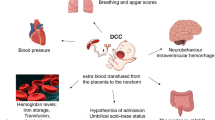Abstract
Objective
To compare the efficacy of enteral paracetamol and intravenous indomethacin for closure of patent ductus arteriosus (PDA) in preterm neonates.
Design
Randomized controlled trial.
Setting
Level III neonatal intensive care unit.
Participants
77 preterm neonates with birth weight ≤1500 g and PDA size ≥1.5 mm, with left to right ductal flow with left atrium to aortic root ratio >1.5:1; diagnosed by 2D-Echo within first 48 hours of life.
Intervention
Paracetamol drops through the infant feeding tube (15mg/kg/dose 6 hourly for 7 days) or intravenous indomethacin (0.2 mg/kg/dose once daily for 3 days).
Outcome measures
Primary: PDA closure rate assessed by echocardiography. Secondary: need for surgical closure of PDA, renal impairment, gastrointestinal bleed, necrotising enterocolitis, hepatotoxicity, pulmonary hemorrhage, sepsis, hypothermia, retinopathy of prematurity, intraventricular hemorrhage, bronchopulmonary dysplasia and mortality.
Results
PDA closure rate was 100% (36/36) in enteral paracetamol group as compared to 94.6% (35/37) in intravenous indomethacin group (P=0.13). The secondary outcomes were also similar between the two groups. There was no occurrence of hepatotoxicity.
Conclusions
Enteral paracetamol is safe but not superior to intravenous indomethacin in the treatment of PDA in preterm neonates.
Similar content being viewed by others
References
Nemerofsky SL, Parravicini E, Bateman D, Kleinman C, Polin RA, Lorenz JM. The Ductus arteriosus rarely requires treatment in infants >1000 grams. Am J Perinatol. 2008; 25:661–6.
Koch J, Hensley G, Roy L, Brown S, Ramaciotti C, Rosenfeld CR. Prevalence of spontaneous closure of the ductus arteriosus in neonates at a birth weight of 1000 grams or less. Pediatrics. 2006;117:1113–21.
Herrman K, Bose C, Lewis K, Laughon M. Spontaneous closure of the patent ductus arteriosus in very low birth weight infants following discharge from the neonatal unit. Arch Dis Child Fetal Neonatal Ed. 2009;94:48–50.
Jhaveri N, Moon-Grady A, Clyman RI. Early surgical ligation versus a conservative approach for management of patent ductus arteriosus that fails to close after indomethacin treatment. J Pediatr. 2010;157:381–7.
Van Overmeire B, Smets K, Lecoutere D, Van de Broek H, Weyler J, Degroote K, et al. A comparison of ibuprofen and indomethacin for closure of patent ductus arteriosus. N Engl J Med. 2000;343:674–81.
Sankaran K, Puckett B, Lee DS, Seshia M, Boulton J, Qiu Z, et al. Variations in incidence of necrotizing enterocolitis in Canadian neonatal intensive care units. J Pediatr Gastroenterol Nutr. 2004;39:366–72.
Gersony WM, Peckham GJ, Ellison RC, Miettinen OS, Nadas AS. Effects of indomethacin in premature infants with patent ductus arteriosus: Results of a national collaborative study. J Pediatr. 1983;102:895–906.
Lago P, Bettiol T, Salvadori S, Pitassi I, Vianello A, Chiandetti L, et al. Safety and efficacy of ibuprofen versus indomethacin in preterm infants treated for patent ductus arteriosus: a randomised controlled trial. Eur J Pediatr. 2002;161:202–7.
Vieux R, Desandes R, Boubred F, Semama D, Guillemin F, Buchweiller MC, et al. Ibuprofen in very preterm infants impairs renal function for the first month of life. Pediatr Nephrol. 2010;25:267–74.
Ahlfors CE. Effect of ibuprofen on bilirubin-albumin binding. J Pediatr. 2004;144:386–8.
Rheinlaender C, Helfenstein D, Walch E, Berns M, Obladen M, Koehne P. Total serum bilirubin levels during cyclooxygenase inhibitor treatment for patent ductus arteriosus in preterm infants. Acta Paediatr. 2009;98:36–42.
Hammerman C, Bin-Nun A, Markovitch E, Schimmel MS, Kaplan M, Fink D. Ductal closure with paracetamol: A surprising new approach to patent ductus arteriosus treatment. Pediatrics. 2011;128:1618–21.
Yurttutan S, Oncel MY, Arayicý S, Uras N, Altug N, Erdeve O, et al. A different first-choice drug in the medical management of patent ductus arteriosus: Oral paracetamol. J Matern Fetal Neonatal Med. 2013;26:825–7.
Oncel MY, Yurttutan S, Uras N, Altug N, Ozdemir R, Ekmen S, et al. An alternative drug (paracetamol) in the management of patent ductus arteriosus in ibuprofenresistant or contraindicated preterm infants. Arch Dis Child Fetal Neonatal Ed. 2013;98:94.
Evans N. Diagnosis of patent ductus arteriosus in the preterm newborn. Arch Dis Child. 1993;68:58–61.
Kluckow M, Evans N. Early echocardiographic prediction of symptomatic patent ductus arteriosus in preterm infants undergoing mechanical ventilation. J Pediatr. 1995;127:774–9.
Young TE, Mangum B. Neofax ® 2010, 23rd edition, Montavale NJ, Thomson Reuters; 2010;180–1.
Bell MJ, Ternberg JL, Feigin RD, Keating JP, Marshall R, Barton L, et al. Neonatal necrotizing enterocolitis. Therapeutic decisions based upon clinical staging. Ann Surg. 1978;187:1–7.
International Committee for the Classification of Retinopathy of Prematurity. The International classification of retinopathy of prematurity revisited. Arch Ophthalmol. 2005;123:991–9.
Papile LA, Burstein J, Burstein R, Koffler H. Incidence and evolution of subependymal and intraventricular hemorrhage: A study of infants with birth weights less than 1,500 gm. J Pediatr. 1978;92:529–34.
Shennan AT, Dunn MS, Ohlsson A, Lennox K, Hoskins EM. Abnormal pulmonary outcomes in premature infants: Prediction from oxygen requirement in the neonatal period. Pediatrics. 1988;82:527–32.
Knight DB. The treatment of patent ductus arteriosus in preterm infants. A review and overview of randomized trials. Semin Neonatol. 2001;6:63–73.
Jasani B, Kabra N, Nanavati RN. Oral paracetamol in treatment of closure of patent ductus arteriosus in preterm neonates. J Postgrad Med. 2013;59:312–4.
Dang D, Wang D, Zhang C, Zhou W, Zhou Q, Wu H. Comparison of oral paracetamol versus ibuprofen in premature infants with patent ductus arteriosus: A randomized controlled trial. PLoS One. 2013;8:77888.
Oncel MY, Yurttutan S, Erdeve O, Uras N, Altug N, Oguz SS, et al. Oral paracetamol versus oral ibuprofen in the management of patent ductus arteriosus in preterm infants: A randomized controlled trial. J Pediatr. 2014;164:510–4.
Author information
Authors and Affiliations
Corresponding author
Rights and permissions
About this article
Cite this article
Dash, S.K., Kabra, N.S., Avasthi, B.S. et al. Enteral paracetamol or intravenous indomethacin for closure of patent ductus arteriosus in preterm neonates: A randomized controlled trial . Indian Pediatr 52, 573–578 (2015). https://doi.org/10.1007/s13312-015-0677-z
Received:
Revised:
Accepted:
Published:
Issue Date:
DOI: https://doi.org/10.1007/s13312-015-0677-z




